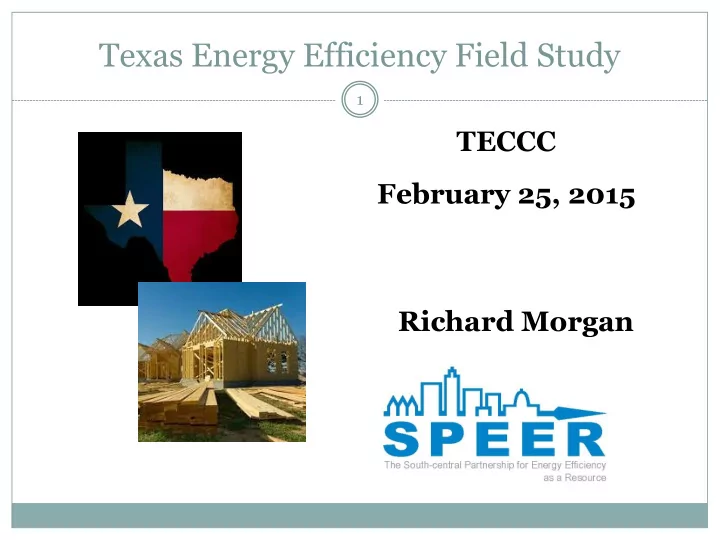

Texas Energy Efficiency Field Study 1 TECCC February 25, 2015 Richard Morgan
The Field Study is: 2 A joint project of SPEER and NASEO in collaboration with SECO and funded by DOE to determine whether an investment in building energy code education, training and outreach can produce a significant, measurable change in residential energy savings.
Data Collection Area 3 Thirty counties in SE Texas: Matagorda to LA, Coast to above Bryan- College Station One of eight states currently engaged : Alabama, Arkansas, Georgia, Kentucky, Maryland, North Carolina, Pennsylvania
Phases 4 Data collection and analysis to establish energy 1. efficiency building practices baseline. 2. Education, outreach and training influenced by data collection findings. Working with EUMMOT (utilities) to design 3. programs to support compliance. 4. Repeat data collection and measure success.
Phase One 5 Baseline Study Performed by a Third Party Obtain permit applications lists from Permit Departments Contact builders for access Site visit of homes under construction – rough mechanical or at final – prior to occupancy. One visit per home to ensure that no home can be identified as code compliant or not compliant Builder will be provided duct and envelope test data Data will be anonymous – no link to address, builder or jurisdiction Data will be analyzed by PNNL
Statistical Validity 6 Random sampling of homes PNNL has established how many samples from which jurisdiction based on permit numbers Data Collection continues until each jurisdiction has the prescribed number of observations of: Window SHGC and U-factor R-value and grade of insulation HVAC & WH equipment characteristics High Efficacy Lighting Duct tightness test Envelope tightness test
Data Compiled in Great Detail 7 REScheck, HERS, or Does Not Other Compliance Code Meets Meet Not Not Field Documentation ID Section Description Requirement Requirement Applicable Observable Observation Format Units Comments Value (if available) Envelo pe Air Leakag e FI17 402.4.2.1 Blower door test results from Number ACH50 Project Team test using RESNET Protocol (ACH @ 50 PA) BD1 NA Blower door test results from Number ACH50 previous test by other parties (ACH @ 50 PA) (for comparison only) FR23a 402.4.1 All joints, seams, and Check penetrations in building thermal Box envelope sealed FR23b 402.4.1 Site-built windows, doors, and Check skylights sealed Box FR23c 402.4.1 Openings between window and Check door assemblies and their Box respective jambs and framing sealed http://www.energycodes.gov/residential-energy-code-field-study
Phase Two 8 Education, outreach and training Establishing local groups for training outreach Speakers Bureau to provide presentations and expertise SPEER staff will provide additional targeted trainings Webinars will be launched for access by rural contractors or jurisdictions CEU credits with all training available Ambassadors provide local area assistance 24 Energy Code Ambassadors, 6 in Field Study area Peer to Peer resource for code officials, builders, etc
9
Additional Resources 10 SPEER provides Advanced Energy IECC 2009 and 2012 Energy Code modules, workbooks and checklists for code officials and builders http://successwithenergycode.com/ SECO has online video Energy Code Training currently available http://www.txenergycodetraining.org/
Phase 3: Utility Review and Analysis 11 EUMMOT collaborating with Field Study to help design new programs to support code compliance. Could include incentive programs, educational programs, or manufacturer rebates…
Phase Four 12 Repeat data collection and baseline study to evaluate success of education, outreach and training program
Project Take-Aways 13 The project will: Develop baseline of industry practices in hew home construction Using education and outreach, encourage the industry to deliver energy savings Expand awareness and understanding of successful practices for code compliance and energy efficiency Develop new programs to drive energy savings for homeowners
Richard Morgan rmorgan@eepartnership.org 512-279-0757 Questions? 14
15
ERI Resources RESNET – Energy Rating Index Performance Path http://www.resnet.us/uploads/documents/EnergyRatings_F actSheet6_Final.pdf U.S. D.O.E. Identification of RESNET HERS Index Values Corresponding to Minimal Compliance with IECC Performance Path http://www.energycodes.gov/sites/default/files/documents/ HERSandIECCPerformancePath_TechnicalReport.pdf Leading Builders of America/NAHB Research Center, IMT, Fact Sheet-Re:188-13 Adding a ratings based compliance path to the IECC http://www.imt.org/uploads/resources/files/Fact_Sheet_on _ERI_Proposal.pdf
17 Implications of the 2015 IECC Energy Rating Index, BCAP http://energycodesocean.org/resource/implications- 2015-iecc-energy-rating-index-eri
Recommend
More recommend